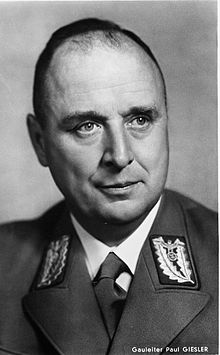Paul Giesler | |
|---|---|
 Giesler in 1943 | |
| Gauleiter of Gau Westphalia-South | |
| In office 9 November 1941 – 26 January 1943 | |
| Preceded by | Josef Wagner |
| Succeeded by | Albert Hoffmann |
| Gauleiter of Gau Munich-Upper Bavaria | |
| In office 23 June 1942 – 8 May 1945 | |
| Preceded by | Adolf Wagner |
| Succeeded by | Position abolished |
| Ministerpräsident of Bavaria | |
| In office 2 November 1942 – 28 April 1945 | |
| Preceded by | Ludwig Siebert |
| Succeeded by | Fritz Schäffer |
| Reichsminister of the Interior | |
| In office 30 April 1945 – 2 May 1945 | |
| Appointed by | Adolf Hitler |
| President | Karl Dönitz |
| Chancellor | Joseph Goebbels |
| Preceded by | Heinrich Himmler |
| Succeeded by | Wilhelm Stuckart |
| Personal details | |
| Born | Paul Heinrich Hermann Giesler 15 June 1895 Siegen, Province of Westphalia, Kingdom of Prussia, German Empire |
| Died | 8 May 1945 (aged 49) Stanggaß, Bavaria, Nazi Germany |
| Cause of death | Suicide |
| Nationality | German |
| Political party | Nazi Party |
| Relatives | Hermann Giesler (brother) |
| Alma mater | Darmstadt University of Applied Sciences Technische Universität Darmstadt |
| Profession | Architect |
| Civilian awards | Golden Party Badge |
| Military service | |
| Allegiance | |
| Branch/service | Royal Prussian Army German Army |
| Years of service | 1914–1918 1939–1940 |
| Rank | Leutnant of reserves Hauptmann of reserves |
| Unit | 1st Foot Guards Regiment 2nd Foot Guards Regiment |
| Battles/wars | World War I World War II |
| Military awards | Iron Cross 1st and 2nd class Clasp to the Iron Cross 2nd Class War Merit Cross, 1st and 2nd class Wound Badge |
Paul Giesler (15 June 1895 – 8 May 1945) was a German Nazi Party politician and SA-Obergruppenführer. From 1941, he was the Gauleiter of Westphalia-South, and he was appointed to the same position for the Gau Munich-Upper Bavaria in 1942. From 2 November 1942 to 28 April 1945, he was also Ministerpräsident of Bavaria. He was responsible for multiple acts of brutality, which included killing opponents of the regime in southern Germany. Giesler was also named in Hitler's Political Testament as Interior Minister, replacing Heinrich Himmler, in the short-lived Goebbels Cabinet. He committed suicide together with his wife in the closing days of the war in Europe.